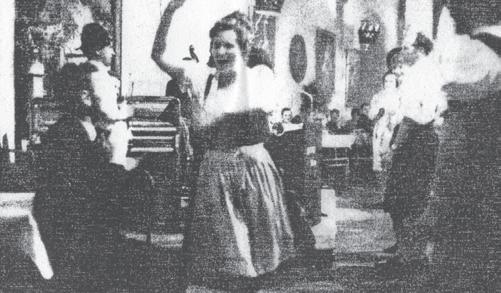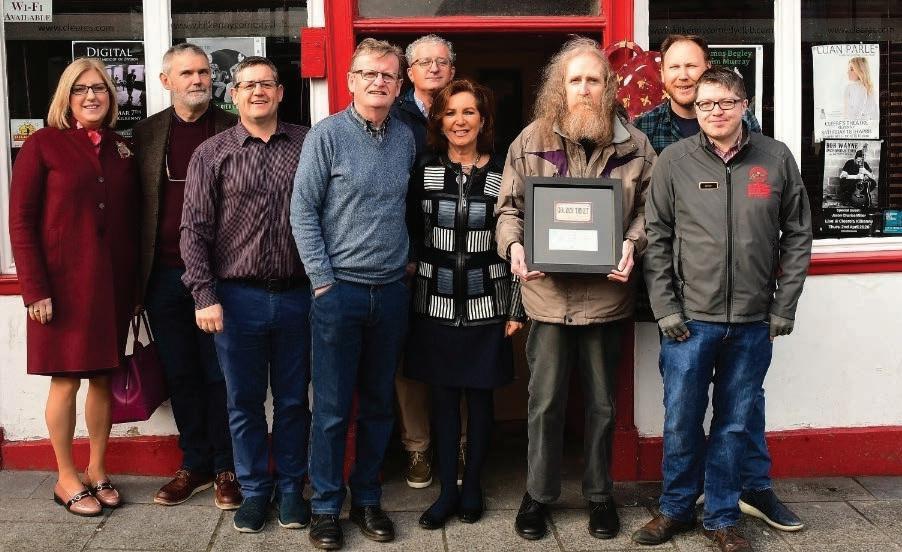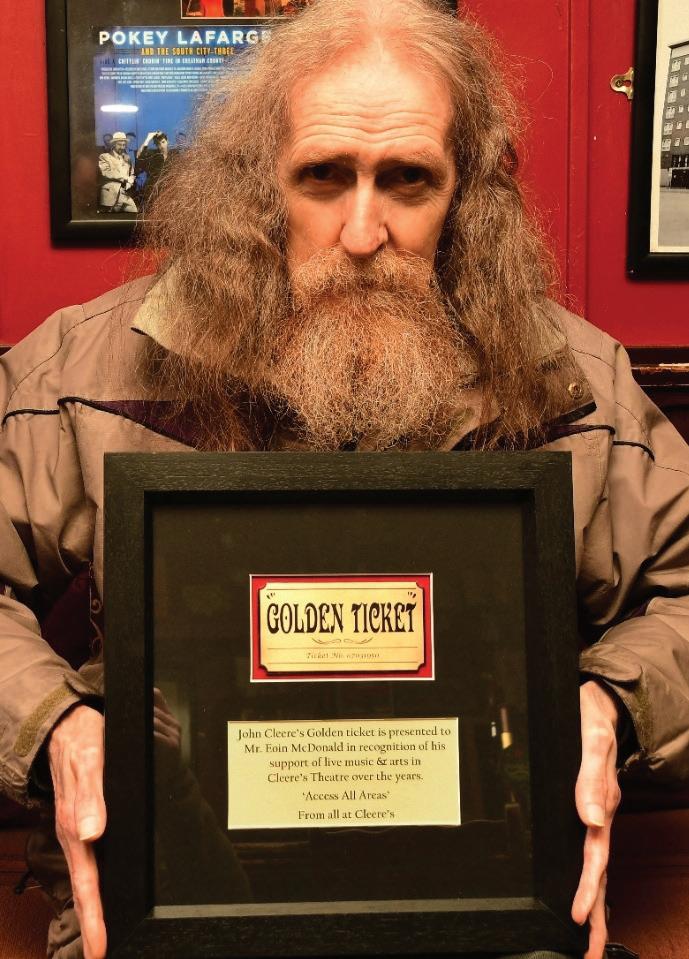
25 minute read
Gerry Moran Ger Cody ..............P24,32,44,45


Advertisement


Furthermore
Gerry Moran Gerry Moran Back to the future with Madame Helena
I am walking down the Castle Road towards the Parade when I see a little camper van parked up, outside Rinuccinis restaurant. The notice on the window caught my eye: ‘Madame Helena. Palm Reading. Crystal Ball. Tarot Cards. Step in.’ And in I stepped.
Madame Helena is lowsized, blondish, sallow complexion and is maybe in her early 40s. “You want a reading?” she smiles beckoning me to sit at a small table and sits across from me. The first thing Madame Helena does is place a crystal ball in the centre of the table, takes my hands, places them around the ball and says: “I want you to make a wish for yourself.” Now I always have difficulty making a wish just for myself (it seems a bit selfish) so I silently wish for the health and happiness of my family. Madame Helena, reading my mind almost, says: “You have a kind face, you love your family and your family loves you but make a wish for yourself.”
And so I wish for my own health and happiness and that of my family.
We then get down to business. Madame Helena tells me she reads the Tarot cards, palms and looks into the crystal ball. Having no idea what the going rate is for a session with a fortune teller I ask how much. “Fifty for all three,” she says.”Thirty for two.” I opt for two not because I’m a cheapskate but because I have only two 20 euro notes in my wallet and I doubt if Madame H takes a credit card (maybe she does!) though I did think 50 was on the steep side.
Replacing my hands on the crystal ball Madame Helena, who herself has a kind face and soft, probing eyes, tells me that I am kind-hearted, a good person, but I need to love myself more! “Throw away all those things you don’t need,” she says as I wonder what those things might be. And I need to have more faith, more faith in the Higher Power because there is a Higher Power, she assures me.
Madame Helena exhorts me to light some candles (I was tempted to tell her about the incident from some weeks back when I lit a candle for a friend in the Black Abbey and ended up having a three hour conversation with a Dominican priest over dinner in my house). There are angels all around me, Madame H, continues, “one of them is your mother who loves you very much and watches over you but she is not smiling. You should try to make her smile”.
Oh dear. I’m beginning to feel like a proper pagan (and perhaps I am). “You’ll live to a good old age,”she then informs me. “I am a good old age,” I say. Madame H smiles.
She then hands me some Tarot cards, tells me to shuffle them and hold on to five. One after another I lay the cards on the table, read aloud what’s on them (and they are all interesting) as Madame H interprets their meaning. Seems I should stay close to water that I should walk near rivers and lakes. I do. I regularly walk down the canal or along John’s Quay.
I should also find a new perspective on things as, according to Madame H’s interpretation of the cards, I need more purpose in life! I should also forget past mistakes. “We all made them, stop blaming yourself,” she announces. “Move on. You’re an educated man but education doesn’t just come from school... [well I know and I hadn’t the heart to tell her that I was in education all my life] we learn from people.”
And then, a comment that really caught my attention, “Keep a diary,” she tells me. “words make you happy and they keep the dementia away.”
That’s when I told her that I actually write a column for a local paper and stepped in to hopefully get one from my visit. Madame H is all ears. “What will you call the story?” she, with those probing eyes, enquires. “I may call it: Back to the future with Madame Helena and it will be positive.”
Madame H suggests a title of her own but then says: “You know best yourself.” As the session ends Madame Helena takes my hands again, places them on the crystal ball and says: “To life, vove, happiness and health.”


Whether you agree or not, alcohol plays a major role for your typical football fan and no. more so than at World Cups down the decades. e World Cup is equal parts sporting event and international celebration, again no more so than in stadiums, and in bars that open early or stay open late to show games.
But the 2022 World Cup in Qatar is unlike any before it. Just two days before the tournament’s rst match in the Muslim nation, o cials made the surprise announcement that fans won’t be allowed to drink beer at the country’s eight World Cup stadiums — a reversal of a previously announced policy.
Alcohol is tightly regulated in Qatar, where customs agents are under orders to seize any booze visitors try to bring into the country.
It’s one of many cultural clashes and potential legal issues that fans might encounter in Qatar, particularly if they’re traveling from more open societies. For a sign of how dramatic the shift in Qatar is, consider that FIFA successfully pressured Brazil to change its federal laws to allow alcohol sales in its stadiums before it hosted the 2014 World Cup — overturning a ban that had been enacted due to violence at its stadiums.
“Alcoholic drinks are part of the FIFA World Cup, so we’re going to have them,” then-FIFA secretary general Jerome Valcke said back in 2012. “Excuse me if I sound a bit arrogant but that’s something we won’t negotiate.”
But that was then. In Qatar, regular fans won’t have access to alcohol at matches. Only spectators in the stadiums’ high-end luxury suites will have easy access to alcohol. Outside of the stadiums, fans can still drink at special World Cup gathering spaces, or at specially licensed restaurants, bars, and hotels around the country.
In general, the public consumption of alcohol is illegal
Footie fans heavily restricted in Qatar

in Qatar — an o ence that can bring up to six months in prison and a ne of more than €800. Anyone smuggling alcohol into the country can face up to three years in prison.
Fans, too, face religious restrictions. Islam is the o cial religion of Qatar — and anyone found to be proselytising for other religions or criticising Islam “may be criminally prosecuted,” according to a factsheet about Qatar for World Cup visitors.
It’s also not safe to assume you can practice your faith openly: “Qatar allows some non-Muslim religious practice in designated areas like Doha’s Religious Complex, but all faiths are not accommodated equally,” the factsheet says.
In addition to import restrictions on alcohol and pornography, “travellers cannot bring pork products” into the country.
Public speech is also limited. Speech that’s deemed critical of the Qatari government could trigger an arrest. ose laws apply both to spoken words and social media.
And, while past World Cups have brought a heaping of argy-bargy — scenes of rival crowds yelling or even singing obscenities at one another — open con icts can bring big problems in Qatar.
“For example, arguing with or insulting others in public could lead to arrest,” a US State Department advisory states.
Homosexuality is criminalised in Qatar. Advocates say that LGBTQ people in Qatar are subjected to conversion therapy, harassment by authorities and imprisonment. Such reports have fuelled outrage, and authorities will be under scrutiny for how they handle LGBTQ fans and symbols.
Visitors to Qatar can also face harsh punishments for
‘If pregnant, bring your marriage cert with you... ”
“indecent acts and the act of sexual intercourse outside of marriage,” according to Qatari law.
Recriminations range from a ne or six months’ imprisonment for anyone found to have committed “immoral” actions or gestures in public to up to seven years in prison for someone having sex outside of marriage. Public debauchery can also carry a sentence up to three years in prison.
If a pregnant fan goes to Qatar for the World Cup, they should be prepared to show a marriage certi cate if they need prenatal care there. When fans are in Qatar, they’ll need to keep their stomachs, chests and shoulders covered.
Fans will need to cover up, despite the heat.
Qatar’s oppressive heat forced the tournament to move from the summer to November and December — but fans who nd it hot there should limit how much skin they show.
Dress codes in many public areas require that “both men and women cover shoulders, chests, stomachs, and knees, and that tight leggings be covered by a long shirt or dress”.
As with alcohol, clothing standards often shift according to the degree a neighbourhood or venue caters to foreigners.
Now, Afghan women barred from gyms
Fifteen months after the fall, again, of Kabul to the Taliban in August 2021, the lot of Afghan people, and girls and women pointedly, is a sorry state. And we seldom hear news from inside a country ruled with an iron rst by fundamentalist Islamic law, as the war in Ukraine daily grabs the headlines.
Since August 2021, when US forces pulled out of Afghanistan after a 20-year presence, the Taliban has banned girls from middle school and high school, de- spite initial promises to the contrary, restricted women from most elds of employment, and ordered them to wear head-to-toe clothing in public.
Taliban enforces orders Afghan women TV news and continuity announcers to the group cracking down on women’s rights and freedoms since they took power more than a year ago. e latest curbs come months after the Taliban ordered access to public parks to be segregated by gender. e ban on women using gyms and parks came into force last week, according to Mohammed Akef Mohajer, a Taliban-appointed spokesman for the ministry. e group has “tried its best” in the past 15 months to avoid closing parks and gyms for women, ordering separate days of the week for male and female access and imposing gender segregation, he said.
“But, unfortunately, the orders were not obeyed and the rules were violated, and we had to close parks and gyms for women,” said Mohajer.
“In most cases, we have seen both men and women together in parks and, unfortunately, the hijab was not observed. So, we had to come up with another decision and for now we ordered all parks and gyms to be closed for women.”
Taliban teams will begin monitoring establishments to check if women are still using them, he said.
A female personal trainer told e Associated Press that women and men were not exercising or training together before at the Kabul gym where she works.
“ e Taliban are lying,” she insisted, speaking on condition of anonymity, fearing reprisals. “We were training separately.”
She said two men claiming to be from the Ministry of Vice and Virtue entered her gym and made all the women leave.
“ e women wanted to protest about the gyms [closing], but the Taliban came and arrested them,” she said. “Now, we don’t know if they’re alive or dead.”
Kabul-based women’s rights activist Sodaba Nazhand said the bans on gyms, parks, work, and school would leave many women wondering what was left for them in Afghanistan.
“It is not just a restriction for women, but also for children,” she said.
“Children go to a park with their mothers. Now children are also prevented from going to the park. It’s so sad and unfair.”

Crocks and Beauties
BY JOHN FITZGERALD
e sideline activities at the Beer Festival are worth a mention too. e Queen of the Land competition attracted hundreds of women, each of them put forward by committees of adoring townspeople, villagers, or the occupants of obscure country lanes, woodlands, and hillsides around the county.
With their sixties hairstyles and dresses, they drew thousands of lusty looks and admiring wolf whistles from the multitude of rst time and seasoned male beer drinkers. e ladies paraded in front of large open-air audiences, to thunderous applause and adulation.
A veteran car rally went down well too, if not exactly as well or as smoothly as the rivers of beer that owed and gurgled down the throats of drinkers. Sixty-four vintage cars- or “old crocks” as cynical observers called them- rolled, rattled, and spluttered along the medieval streets, led by the New Ross Brass and Reed band. e convoy of quaint vehicles arrived from Waterford on day one of the festival and headed towards the brewery, where they lay at anchor for the night. ey were later driven through the City up to the Castle.
Quite a few of the drivers had dressed in period costume, each one to match the advanced age of his car. One amboyant gentleman; attired in shimmy frock, beads, and aunting a two-foot long cigarette holder, waved to the crowds and had people in stitches laughing at him. J. Shelly of Callan said the rally had given him with the biggest thrill of his life.
Another car carried a group of “Flower Power” singers who sang of peace, a perfect world, and free love. e latter concept was of course alien to Kilkenny in 1964.
A jittery looking machine, aptly titled “Crock of Ages” broke down in High Street and had to be pulled by Phil Dwyer’s jaunting car, an old reliable if ever there was one. e oldest car on display was a 1907 “Nag” driven by the legendary Ossie Bennett of Tipperary hurling fame.
Finalists of the Beauty Queen competition also got to ride in the vintage relics of auld decency. Hearts palpitated…passions ran amok…grown men swooned or threw kisses at the provocatively dressed ladies who waved daintily at them like ambassadors of love. e Mayor, P. Delaney, was delighted with the car rally and the standard of entry among the Beauty Queen contestants. “When I look at all these four wheeled historical bits and pieces”, he announced, “it reminds me of how far the motor industry has come in recent decades. We’ve made progress, thank God.”
Elsewhere in the city, two ballrooms were packed to capacity with dancing couples. ere was racing and show jumping at Gowran, and a plethora of other events on the fringes of the city like boxing, wrestling, basketball, donkey races, and darts competitions.
But back to the beer tent… and the pubs of Kilkenny that extended opening time beyond 2 p.m. By midnight, thousands of decent citizens had consumed enough beer, according to a local newspaper report, to ll the historic Walkin’s Lough that used to ood Kilkenny in years gone by. is advanced state of inebriation led to some memorable funny… and not so funny… incidents. As the witching hour passed, a lively fellow removed the tablecloth in the beer tent and leaped up on the table. Staggering in all directions, he asked everyone present to behold the greatest dancing performance of their lives.
He performed a Cossack dance that many drinkers found exhilarating and that made others slightly dizzy… such was the majesty and deftness of his foot work and body movements. “Japers…I thought I was in Russia there for a minute” was the verdict of one dewy-eyed drinker. To be continued…
Strike up the band
Dancing at the Castle Festive spirits







When asked by Billy Connolly for help changing a tyre, Eoin apologised, saying he was a huge fan but he was rushing to a gig

e death of Eoin Mac Donald, lover of the arts, shocked the city, as people agreed that Kilkenny had lost a legend. Former classmate and friend John Cleere pays tribute to Eoin
BY JOHN CLEERE
“A pint of zzy orange please.”
It’s an hour before doors open, but Eoin has arrived and has taken up position. e anorak will be placed on his stool at the back of the venue. Eoins is usually the only stool allowed on the busy nights.
How many shows has Eoin attended over the years? In Cleere’s it runs into the hundreds, plus shows in e Watergate, e Set, Billy Byrnes, Ryans, St Canices Cathedral, Kilkenny Castle and any other venue in town that ventured into the entertainment business. Eoin was primarily a music fan, but was also a regular at opera, classical, ballet, jazz, theatre. Standup comedy is the only format that I can’t remember him attending.
He was a huge supporter of young artists and bands taking their rst steps on the musical ladder. Andrew Mc Guinness recalls him attending every “Battle of the Bands” gig in e Zoo Club and giving encouragement to all the young performers. e Roots Festival played a special part in his life, but he was also a big supporter of the Kilkenny Arts Festival and a wide range of other events in Kilkenny. He ventured further to gigs, particularly in Vicar Street with his great friend, Paul Campion, on driving duties. I remember him telling me about being invited backstage to meet one of his favourites, Randy Newman. He told me behind him waiting to be ushered in were Paul Brady and Bono. I’m sure both of them were wondering who the tall guy with the long hair was ahead of them in the queue.
His nephew, Simon, told the story of him going to London for a gig and passing a driver changing a tyre. He asked Eoin could he give him a hand. “Sorry Billy, I know who you are, but I can’t help. I’d be late for the show.” It was Billy Connolly down on his hands and knees. e show always came rst.
Eoin and I attended Kilkenny CBS at the same time. I was looking recently at a picture of our 1968 Leaving Cert class. e smiling Eoin is fourth from left in the middle row, with myself and Gerry Moran, of this parish, on the left in the front. ere wasn’t a lot of music to be heard in those days, just the odd programme on Radio Luxembourg or pirate stations like Radio Caroline. Despite the lack of musical events, both live or on TV/ Radio, we developed a huge interest in music, none more so than Eoin. When we opened our venue in Cleere’s in the early nineties, Eoin became our biggest supporter. Whether half a dozen or a full house showed up for a play or a gig, you could be sure that he would be there.
I’m not sure when the practice of keeping Ticket No 1 for Eoin began, but this became the norm over the years. All these were kept and meticulously led at his house in New Street for every show he attended. ere was consternation one year before the Kilkenny Roots Festival when some “Ticket No 1’s” were sold before being put aside. e buyers were tracked down and the tickets returned and allocated to their rightful owner. “Ticket No 1” has now been retired and will not be sold at future festivals.
Cleere’s presented Eoin with a “Golden Ticket” a few years ago, granting him admission to all future events in recognition of his support over the years. Warm tributes were paid by Kilkenny Arts Festival, e Watergate eatre and various music venues also. Pat Crotty from Paris Texas related the story of Table No 8 in the restaurant, which was always held for Eoin and his brother, Dan. A good lunch, a pint of orange and a gig at any venue around town was the ideal day for Eoin. Not a bad recipe for life.
‘Ar dheis Dé go raibh a h’anam dílis’
John And Phyl Cleere opened Cleere’s Bar & eatre in 1988. e venue is now run by John Holden and Paul McCabe, who have continued to organise a full programme of events throughout the year. John was among the founders of the Smithwick’s Kilkenny Roots Festival in 1998 and is currently Festival Director. He is looking forward to presenting an exciting range of acts on the 25th Anniversary in 2023.




Beef outlook not great as inflation bites deeper
e next year for Ireland’s beef industry remains uncertain, according to Bord Bia, as consumer demand in Europe is impacted by the cost-ofliving crisis.
In recent months, there has been some downward across Ireland’s European beef export markets, as consumers began to adjust to increases in the cost of living.
After energy, food has been the second biggest driver of in ation and European retailers have acted over recent months to increasingly focus on value in order to retain market share, Bord Bia said in a statement to the Farming Independent.
Latest forecasts from the European Beef Forecasting Group indicate a 1% reduction in beef consumption for 2022, with 4% less in Germany and 1% decreases in France and Sweden. e weaker demand for higher-value steak cuts in particular has been partially o set by a strong forequarter beef trade, especially for manufacturing product. e EU beef herd is expected to continue to decline next year, with a small recovery in beef production expected in Britain.
Rising living costs in these key markets for Irish beef are expected to continue to impact on beef demand, with consumer concerns around sustainability, animal welfare and personal health further impacted by value-for-money concerns, Bord Bia said. Figures from Bord Bia show that the most recent cattle kill forecast has indicated that the annual cattle kill through department-approved plants will reach 1.81m head for 2022, that is an an increase of 120,000 from the levels for 2021. is increase has been driven by higher numbers of slaughter-age cattle available on Irish farms during 2022, reduced exports of slaughterage cattle to the North and also the decision by some to kill cattle younger and lighter than previous years.
According to the deaprtment, early indications for 2023 are that we will see a reduction in cattle availability in 2023, with a forecast kill of 1.78m.

Tributes paid to woman who was killed by falling tree
A Pilton woman farmer lay dead on her own land for more than 24 hours after she was pinned by a falling tree branch, it has emerged.
Gardai believe one of Mary O’Shea’s dogs refused to leave her side until passersby found her body. “ e dog stayed by her side the whole time,” a source said. e body of Ms Mary O’Shea – who was also a well-known local historian in her 60s – was pinned to the ground by the heavy branch that fell from a tree when she was cutting it.
Her body was found at her home near Piltown on the evening of Saturday, November 19 – but sources say she was last seen early on the Friday and she is believed to have died later that day.
Ms O’Shea was well-known in the area, locals said.She was an only child and was unmarried and was predeceased by both her parents, locals said.
As well as being a farmer, Ms O’Shea was also a noted writer and member of the South Kilkenny Historical Society.
A Gardas spokesperson said: “A woman in her 60s received fatal injuries and was pronounced dead at the scene. Her body has been removed to the Mortuary at University Hospital Waterford. A le will be prepared for the coroner.”
Sources said foul play had been ruled out and her death was a tragic accident.
Fine Gael councillor Pat Dunphy said everyone in the area was shocked by her death. “I would like to pass on my sympathy and those of the people of Piltown to her relations.
“She was a very popular woman. She worked on her farm and also had a strong knowledge of local history. It was very sad.”
Parish priest Fr Paschal Moore paid tribute to her, saying: . “She lived alone but she was very much involved in community life. She was a local historian and wrote a book on the area a few years ago. She was a wonderful person and was a great help in the parish when tourists came looking for their family roots..
“And she was a very good friend. She will be missed in the community.”
Eddie Synnott, of the South Kilkenny Historical Society, where Ms O’Shea was the joint treasurer, said: “She was a very good historian and was able to express her knowledge. She was also an intellectual and a wonderful woman.” If we want our local stores and businesses to reopen their doors in January, now is the time to stay loyal, Champion Green founder Marian O’Gorman, said at the launch of Green Friday.
While many businesses and organisations act on environmental sustainability, the business leader says that supporting local SMEs is key to living sustainably, protecting social resources locally, and regenerating the health and wealth of communities.
Launched in 2019, on the back of concern for local businesses losing out to global e-commerce, Green Friday is deemed a sustainable alternative to the shopping promotion Black Friday.
Ireland’s support local campaigners are asking that people support local industry and jobs, and keep money circulating locally, for the sake of healthy vibrant sustainable communities.
Every €1 spent in local retail can generate up to €2.50 in the economy. €1 spent online, with an overseas retailer, is largely lost to the local economy, the promoters of Green Friday, outline.
In the month ahead of Christmas, consumers here will spend about €4.5 billion in total.
“If we spent this money, domestically, the impact on jobs, local investment, our communities and the wellbeing of ordinary people, would be powerful,”Minister for Business, Employment and Retail Damien English TD said.
Evelyn Moynihan of Kilkenny Design said that consumer consciousness was real, and there was more demand than ever for locally-designed and made gifts that will last.
“We may buy less in 2022, but the trend is towards responsible gifts and lasting quality. e value of sustainable community is all the more obvious in a world where climate crisis, con ict, and over-reliance on global business giants can drive both in ation and displacement,” she said.
Up to €50 million is likely to be spent in Ireland over the Black Friday weekend, which, in reality, has extended to a fortnight of online and instore sales promotion, rather than the one-o exclusive or valuable discounts, Green Friday advocates say.
Small Firms Association Acting Director Elizabeth Bowen said: “We are calling on consumers to support their communities by shopping in small businesses and buying local sustainable gifts or Irish-made products this Green Friday”.

‘Use it or lose it’ is the hard hitting green message
Agri sector needs to be more climate conscious
For food safety purposes and market demands for bioenergy production, it is paramount that the agricultural sector worldwide becomes more climate resilient. As temperatures rise, rainfall patterns change and pests and diseases mutate, food and farming systems face increasing threats. is webinar will focus on solutions to reduce the climate footprint of livestock raising – an issue of major concern to both Brazil and Ireland.
In Ireland, agriculture accounts for over 37% of greenhouse gases (GHG) emissions. Recently, the Government set a ceiling for emissions in the sector, requiring a 25% reduction by 2030 compared to 2018 levels. e Brazilian livestock sector has incorporated increasingly sustainable practices. In April 2021, the Brazilian Ministry of Agriculture, Livestock and Supply (MAPA) created the ABC+ Plan for the adaptation of agriculture to low carbon emissions systems. e observed trend in the Brazilian beef industry is to marginally increase the herd while reducing the grazing areas. Furthermore, the renowned Brazilian Agricultural Research Corporation (Embrapa) will cover the Carbon Neutral Beef (CNB) brand and method of production, a seal which certi es beef produced using systems that neutralise methane gas emissions.
Join this webinar to discuss challenges and best practices to reduce the environmental footprint of the livestock breeding with panelists from Brazil and Ireland.
e event will be an opportunity to open up a discussion forum between Brazilian and Irish stakeholders. e con rmed panellists to date are: • Dr. Paul Crosson, Beef Enterprise Leader, Teagasc, Agriculture and Food Development Authority • Prof. Tommy Boland, Associate Dean of Research Innovation and Impact, School of Agriculture and Food Science, University College Dublin • Dr. Mariana de Aragão Pereira, Senior Researcher, Embrapa, e Brazilian Agricultural Research Corporation • Luiza Bruscato, Executive Manager, Brazilian Roundtable on Sustainable Livestock (GTPS) • Gracie Verde Selva, Executive Sustainability Manager, Minerva Foods










